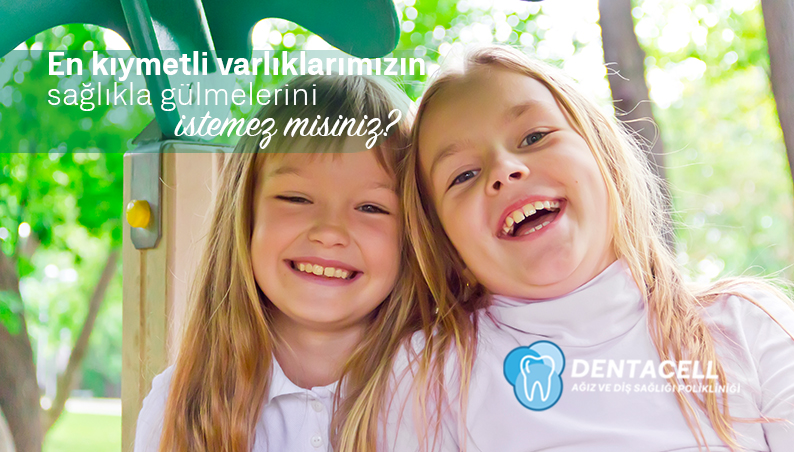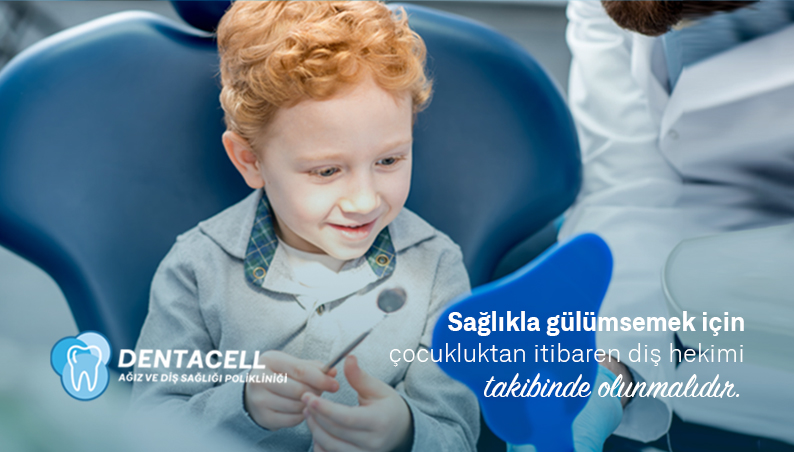Pediatric Dentistry
Milk Teeth
Milk teeth begin to develop when they are 2-3 months old in the womb. Therefore, the mother’s diet is an important factor for the child’s teeth to be healthy.
Bottle caries is seen in 2-4 years old children with the destruction of upper incisors; It is an important problem that parents should pay attention to.
The idea of milk teeth will fall and teeth will be replaced again. ” Causes your child to have dental problems in the future.
Milk teeth rot more easily with more organic matter content than permanent teeth.
It is not possible to completely prevent the consumption of sugar, which plays an important role in both the intelligence and body development of children. However, to minimize harmful effects, it is necessary to prevent the consumption of meals and brush teeth immediately after consumption.
If milk teeth are prematurely withdrawn, there is no room for permanent teeth and collisions occur.
Teeth, Driving Time, Falling Time
I (front cutter), 6-12 months, 7 years
II (side cutter), 6-12 months, 8 years old
III (canine tooth), 18-24 months, 10 years
IV (first molar), 12-18 months, 9 years
V (second molar), 24-30 months, 11 years
Permanent Teeth
Your child’s teeth, which will remain in his mouth for life, begin to come out at the age of six. The first teeth are the first molars and are the teeth that are often left as decayed by families and left to decay. However, these teeth are the most important in the tooth array.
The front incisors, which begin to emerge around the age of 7, cause the jaw bone to expand and cause the milk teeth to open. Thus, permanent teeth in the expanding jaw bone take their place in beautiful shape.
Front incisors, finger sucking, mouth open sleep, etc. For reasons, they can stay outside the dental array. In such cases, the dentist should be contacted immediately.
The lower anterior incisors may be accidentally withdrawn by assuming a milk tooth when it first comes out. For this reason, we need to follow the change of the teeth of our children carefully.

Attention!
Therefore, it is necessary to carefully follow the change of the teeth of the children. Otherwise, the decay of our teeth will become inevitable.
Baby Bottle Caries
Sweeteners such as sugar, honey, and molasses should not be added to the bottle in the bottle, water should be included after feeding the baby and after the feeding of the first teeth, it should be cleaned by wiping the teeth with a clean wet cheesecloth.
To Prevent Caries Formation
Fissure sealants;
The most common places of dental caries are pits called fissures on the chewing surfaces of the teeth.
Before caries starts to form, the materials called fissure sealant can be applied to the fissures of the teeth and the formation of caries in these areas can be prevented.
Fluoride applications;
Superficial fluoride applications increase the resistance of teeth against caries.
The application of such short, painless and preventive treatments will positively affect the child who comes to the dentist for the first time.
Thanks to preventive dental treatments, future problems in the teeth of the children are prevented before they grow. Also, both treatment time and difficulty and costs are reduced.
Placeholders for Early-Drawn Milk Teeth;
To fill the gap formed in the milk teeth, which is inevitable to be extracted in the early period, the neighboring teeth slide towards the cavity and permanent teeth coming from the bottom cannot find a place to come out. In this case, after removing the milk tooth, the appliances called ‘placeholder’ must be made instead. Thus, orthodontic disorders that may occur in the future due to early drafts are prevented.
Emergency Dentistry in Children
As many of us know, children learn to walk and dream. These falls can usually be overcome without damage, and sometimes they may encounter unwanted situations. If your child is in a period of milk dentition (0-6), sometimes the anterior milk teeth can be completely or partially buried in the jaw bone due to age bumps and falls.
Usually, within 3-9 months, these teeth rub back from their old places. However, a dentist should be consulted as soon as possible, as there may be fractures in the jaw as well as the possibility of damaging the permanent teeth under these teeth during impact.
If a broken / cracked or gum injury occurs in the child’s permanent front teeth as a result of falling or bumping, it will prevent swelling that may occur after rinsing the mouth with warm water and applying a cold compress to the injury. Also, if the broken piece can be found, it should be taken to the dentist immediately.
The chances of healing are very high when the permanent teeth that are removed as a result of the injury are reinserted. In cases where the tooth comes completely out of the socket, the tooth should be kept without touching the root tip from where it fell, and saline should be sent to the dentist without delay by placing it in water if it is not found.
One of the most common conditions is a sudden toothache, which usually occurs at night. In such cases, rinse your mouth with water first to make your child comfortable. Then clean your teeth with a toothbrush and floss. Thanks to these two methods, you can easily pass your child’s toothache by removing food residues stuck between the teeth. If the pain does not disappear even though these two procedures are performed; the painful condition that we call pulpitis pain in the teeth has started.
Apply cold or ice to the area of the aching tooth to alleviate the existing pain. The cold application will cause pain relief. Never apply ‘hot water’ or ‘aspirin’ on the aching tooth. If, despite all these procedures, the pain is not relieved, using a painful syrup or tablet recommended by your dentist will decrease the pain.


